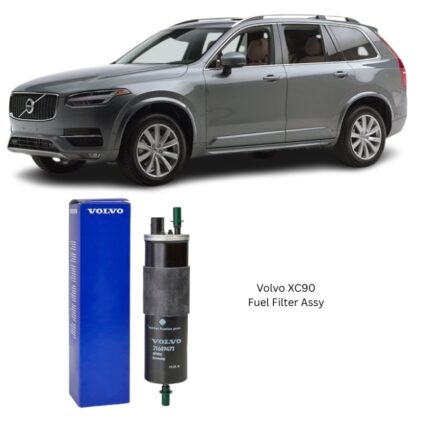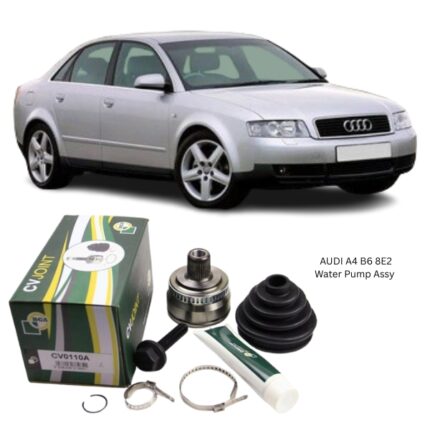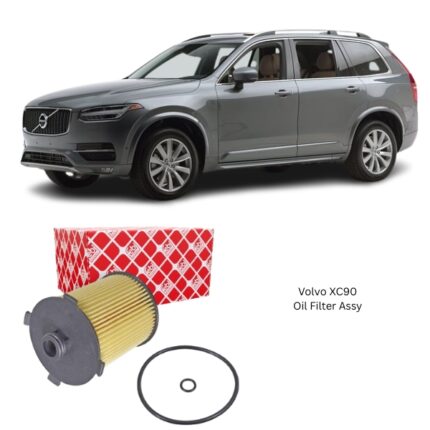Get Volvo XC90 Oil Filter Assy 31372212 in Kenya
The oil filter assembly is a vital component in an internal combustion engine’s lubrication system, tasked with one of the most critical functions—removing contaminants from engine oil before it circulates through the engine’s moving parts. Its job is to ensure that the oil remains clean, free from harmful particles, and capable of providing the necessary lubrication and cooling for optimal engine performance and longevity. Without a properly functioning oil filter, the engine would be exposed to abrasive wear, sludge buildup, and potential damage, leading to reduced efficiency or even catastrophic failure.
Purpose and Function
Engine oil serves multiple roles—lubricating moving parts, reducing friction, dissipating heat, cleaning engine internals, and forming a seal between piston rings and cylinder walls. However, over time, oil accumulates contaminants such as:
-
Microscopic metal particles from engine wear
-
Carbon deposits from combustion
-
Dust and dirt that enter through the air intake
-
Residual sludge and varnish from oil degradation
If left unfiltered, these contaminants would circulate through the engine, causing premature wear on bearings, camshafts, pistons, and other components. The oil filter assembly removes these impurities, ensuring that only clean, well-lubricated oil reaches the engine’s critical parts.
Construction and Design
An oil filter assembly is more than just a simple canister—it is an engineered unit designed to withstand high pressures, temperature fluctuations, and prolonged exposure to oil. It generally consists of the following main elements:
-
Filter Housing – The outer shell or casing, typically made from corrosion-resistant steel or durable synthetic materials. This shell protects the internal components and ensures the filter can withstand oil pressure without deformation.
-
Filter Media – The core functional material inside the filter that traps contaminants. Modern filters use a blend of cellulose fibers, synthetic fibers, or micro-glass media. The filter media is often pleated to increase surface area, allowing greater dirt-holding capacity without restricting oil flow.
-
Center Tube – Located at the core of the filter media, the center tube supports the structure and allows filtered oil to flow back into the engine.
-
End Caps – Attached to both ends of the filter media, these caps hold the structure together and prevent oil bypassing the filter element. They are usually made from metal or a heavy-duty synthetic resin.
-
Gasket/Seal – Located at the mounting base, this rubber or silicone gasket ensures a leak-proof seal between the filter and the engine’s filter mounting point.
-
Anti-Drainback Valve – A one-way valve that prevents oil from draining back into the oil pan when the engine is off, ensuring oil is immediately available upon startup.
-
Bypass Valve – A safety feature that opens when the filter is clogged or during cold starts when oil is thick. It allows oil to bypass the filter and reach the engine, preventing oil starvation in critical situations.
Filtration Process
The filtration process begins when the engine’s oil pump forces oil through the filter housing. Oil enters through multiple small holes in the filter baseplate, passes through the filter media where contaminants are trapped, and exits through the central outlet hole.
The filter media works in two main ways:
-
Surface Filtration – Larger particles are trapped on the surface of the fibers.
-
Depth Filtration – Smaller particles are trapped deeper within the media’s layers.
This dual action ensures that the oil leaving the filter is clean, allowing for smooth lubrication and protection of the engine’s internal parts.
Types of Oil Filter Assemblies
While the function is the same, oil filter assemblies come in different designs depending on engine type and service requirements:
-
Spin-On Oil Filters – The most common design, consisting of a metal canister containing all filtration components. They are replaced as a single unit and screw directly onto the engine’s filter mount.
-
Cartridge Oil Filters – These filters use only the filter element without the metal housing, fitting into a permanent filter housing in the engine. They are more environmentally friendly as only the filter media is replaced.
-
Magnetic Oil Filters – Incorporate magnets to capture ferrous metal particles in addition to traditional filtration.
-
High-Performance Filters – Designed with premium synthetic media for enhanced filtration efficiency, often used in high-stress or high-performance engines.
Maintenance and Service
An oil filter assembly must be replaced at regular intervals to maintain optimal engine health. Over time, the filter media becomes saturated with debris, restricting oil flow and potentially triggering the bypass valve. While the bypass valve protects against oil starvation, it allows unfiltered oil into the engine, which can accelerate wear.
Best practices for oil filter maintenance include:
-
Replacing the filter during every oil change.
-
Using filters with the correct specifications for the engine’s oil pressure and flow requirements.
-
Ensuring the gasket is properly seated to prevent leaks.
-
Applying a light coat of oil to the gasket before installation for a proper seal.
Performance Considerations
A high-quality oil filter assembly should:
-
Capture Efficiency – Remove particles as small as 20–30 microns with high efficiency.
-
Dirt-Holding Capacity – Hold enough contaminants without restricting oil flow.
-
Durability – Withstand high oil pressures (often over 100 PSI during cold starts).
-
Temperature Resistance – Operate effectively in temperatures ranging from sub-zero cold starts to extreme engine heat.
-
Seal Integrity – Maintain leak-proof operation over its entire service life.
Common Oil Filter Issues
Neglecting proper oil filter maintenance can lead to several problems:
-
Clogged Filter – Reduces oil flow, causing engine components to run without sufficient lubrication.
-
Oil Leaks – Caused by a damaged gasket or improper installation.
-
Bypass Valve Failure – May allow unfiltered oil into the engine even when the filter is not clogged.
-
Media Collapse – Due to extreme pressure or poor-quality filter materials.
Impact on Engine Life
A well-maintained oil filter assembly significantly extends engine life by ensuring that:
-
Bearings and crankshaft journals are protected from abrasive particles.
-
Hydraulic lifters and variable valve timing systems function smoothly.
-
Oil passages remain unclogged, ensuring full lubrication.
-
The risk of sludge formation and overheating is minimized.
Environmental Considerations
Spent oil filters contain used engine oil, which is hazardous to the environment. Disposal should follow proper recycling procedures. Cartridge filters, which produce less metal waste, are increasingly favored for environmental sustainability.
Follow Us On Facebook For More Parts.





Reviews
Clear filtersThere are no reviews yet.